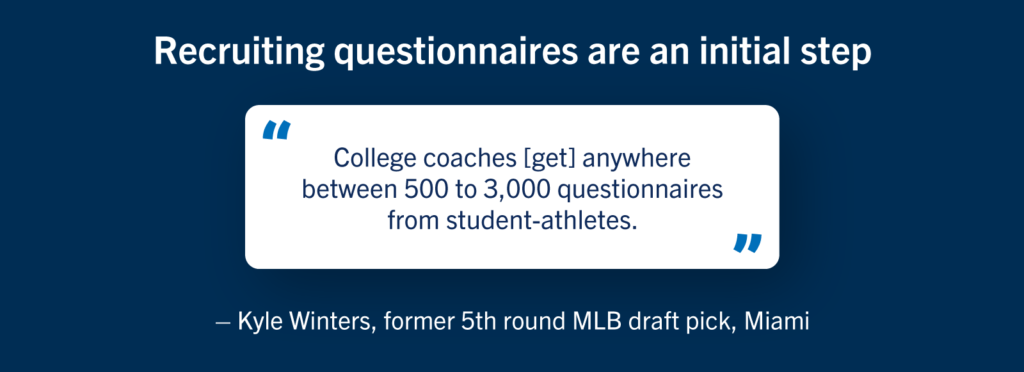

When they think of college recruiting, many student-athletes and families think it’s all about getting seen by college scouts at high-profile events. While that certainly helps, the truth is that for most prospective student-athletes, college recruiting is a long process and includes a lot of communication with many college programs.
Filling out a recruiting questionnaire, whether it’s a football recruiting questionnaire, a recruiting questionnaire for basketball or for another sport, is one of the first steps in the recruiting process. You’ll want to use college questionnaires to your advantage to have a successful college recruiting experience.
A recruiting questionnaire is a form that prospective student-athletes fill out to share information about themselves with a college program. It is usually located online but sometimes it is mailed. College coaches use this information to see if student-athletes meet basic standards and are potentially a good fit for the program.
Recruiting questionnaires serve several purposes, including:
These days, recruiting questionnaires are mostly found online on college programs’ websites. While not every team has one, they are very common. They usually include information such as:
Recruiting questionnaires can include other information too, such as preferred position or hobbies. It all depends on the program. Here are a few sample questionnaires:
Recruiting questionnaires are an initial step

Prospective student-athletes can fill out as many recruiting questionnaires as they want, and college coaches can send out hundreds and sometimes thousands of recruiting questionnaires to student-athletes. So, how are they useful? Here are a few ways:
To a large extent, the recruiting process is like a funnel. College coaches want to recruit student-athletes that show initiative and interest. Filling out a questionnaire shows that a student-athlete has a basic level of interest and college coaches often weed out those that have not filled out a questionnaire.
Additionally, college coaches are very busy. Allowing prospective-student athletes to fill out relevant recruiting information in advance saves them a lot of time that they can then spend on evaluating prospects.
Finally, recruiting questionnaires are a great reference tool for college coaches. If they like what they see, they can then check out an athlete’s NCSA Recruiting Profile for more information and keep tabs on them during recruiting events.
Filling out a questionnaire is a good starting point in the recruiting process. It is especially recommended as a first step for younger student-athletes. It’s something student-athletes can do before they start being evaluated in-person by college coaches in later years.
Many coaches recommend filling out questionnaires freshman year, and top prospects may even do so before that. However, the information that student-athletes include changes over time and will therefore need to be updated. For example, measurables like height and weight will change over time, as well as stats such as vertical jump or honors such as an all-conference designation.
College programs will also experience coaching changes that may result in updated databases. That’s why it’s important to update recruiting questionnaires, especially at target schools student-athletes are most interested in.
To update a questionnaire, student-athletes can fill a new one out or save time by using Recruit Spot. This tool allows users to fill out more than 8,000 college questionnaires at once.
If a college coach sends you a recruiting questionnaire, that’s a good sign. It usually means that a college coach wants to get you on their recruiting radar. However, you’ll want to temper your expectations. It doesn’t mean that a college coach is recruiting you.
College coaches often send out hundreds of recruiting questionnaires to potential recruits just so they can get them in a database. Because recruiting questionnaires do not count as recruiting materials, college coaches can send these out before they are allowed to make recruiting contact at the D1 and D2 levels (usually June 15 after sophomore year or September 1 of junior year).
While potential recruits shouldn’t put too much weight on this, it’s more encouraging to receive a questionnaire before recruiting contact is allowed than receiving one after it’s allowed. This is a sign that the college coach wants to get you on their radar early in the process.
Finally, student-athletes that do receive a recruiting questionnaire should respond quickly by filling it out. A slow response time can send a signal to the college coach that maybe they’re not interested in the college program or are slacking.
As we mentioned before, so much of college recruiting really comes down to keeping up communication with college coaches. It’s one of the best ways to stay on their radar and show interest. That’s why after filling out a recruiting questionnaire, it’s a good idea to follow up with the college program with an email.
At this point, the college coach may respond to the student-athlete or if it’s early in the process or before recruiting communications are allowed, they can at least tag them in their database as a potential prospect.
Read next: